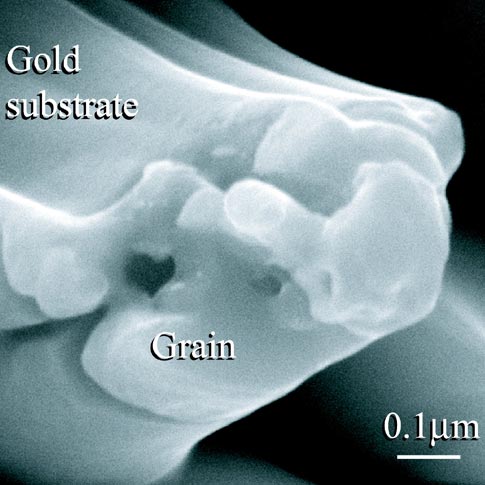Key Takeaways:
It’s not the same as having a sample return mission to, say, Aldebaran, but it’s still pretty awesome: mounted on a gold pedestal in a laboratory in the Carnegie Institute of Washington and then bombarded by ions, a grain of less than a micrometer has confessed that it came from a different star.
According to research published in the December 19 Astronomy & Astrophysics, the crystal probably formed near a star of intermediate mass, 4 to 7 times that of the Sun, which was nearing the end of its life and had entered the red-giant stage.
Lead author Maria Lugaro, an Italian astronomer at Utrecht University in the Netherlands, says finding and analyzing similar specks could yield important information about the conditions inside red giants.
The speck in question has been christened OC2. No one knows precisely how it got to Earth. It was found in residue left after pieces of three stony meteorites, or chondrites, were dissolved in acid to analyze their contents. So OC2 may have landed in Bishunpur, India, in 1895, in Semarkona, India, in 1940 or in Krymka, Ukraine, in 1946.
In any case, it was snugly embedded in stuff that once was part of an asteroid, which, before that, made up the Sun’s primordial cloud of gas and dust. Sometime before the solar system’s formation, OC2 must have drifted in and been mixed up in its history.
Recognizing a grain as pre-solar isn’t a big deal anymore. Scientists have identified a few thousand made of various minerals including corundum, hibonite and spinel. The grains are recognized by weighing some of their constituent atoms. This happens in a mass spectrometer, after an ion beam has struck them loose.
In the case of spinel, a ruby-like crystal that consists of magnesium, aluminum, and oxygen atoms, the magnesium atoms of the pre-solar variety turn out to be heavier, on average, than in the same material from the bulk of meteorites. The magnesium contains more of the variants, or isotopes, with atomic weights 25 and 26. In OC2, this is even more pronounced.
Computer models of how stars burn up their hydrogen fuel into helium, and so on to heavier elements, can follow magnesium as it is formed, transported by currents of hot gas, and, eventually, spewed out into space. In a red giant of intermediate mass, in particular, a phenomenon called “dredging-up” brings hot material from a deep, helium-burning layer to where hydrogen is being consumed.
All this affects the survival rates of different magnesium isotopes, which determines their ultimate mix.
This research is as much astronomy as it is chemistry, nuclear physics, and laboratory analysis, Lugaro says. Her co-authors come from all those disciplines, and from four different countries. Their conclusion that the parent star of OC2 should be a red giant of intermediate mass — although, at this point, a low-mass red giant is also conceivable — is all the more exciting as information on the chemical composition of these stars is scarce.
Once researchers find siblings of OC2, and astrophysicists get more confident about what type of star must be their source, the tables can be turned: They will then start demanding computer models produce dust grains like OC2.










